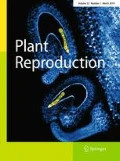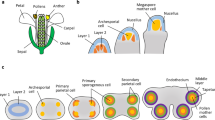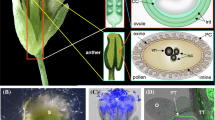Abstract
Sperm cells—the male gametes of flowering plants—constitute the male founding lineage of angiosperms, possessing the unique capacity to fuse with the egg and central cells during double fertilization. Although it is well established that these cellular fusions are involved with initiating the development of the seedling-forming zygote and the endosperm that nourishes it, considerable information will be needed to characterize the full male molecular repertoire, which includes expressed genes of the male lineage, encoded proteins, and regulatory elements controlling male germ line identity, as well as male molecules that may mediate interactions with the female partner that initiate fertilization and development. Progress is being made using increasingly sensitive molecular methods to uncover important genes. With the pace of this discovery rapidly increasing, the likely outcome is that key molecules will be discovered within the next several years that control the founding cells of the embryo and endosperm and are involved in directing early development. Further insights into the genes and gene pathways that regulate male germ line differentiation will advance not only our fundamental understanding of these reproductive cells, but also the nature of cell–cell recognition, membrane fusion, double fertilization, zygote activation, early plant development and may aid our understanding of factors that have contributed to the overwhelming evolutionary success of flowering plants.




Similar content being viewed by others
References
Andrews J, Bouffard GG, Cheadle C, Lu J, Becker KG, Oliver B (2000) Gene discovery using computational and microarray analysis of transcription in the Drosophila melanogaster testis. Genome Res 10:2030–2043
Baarends WM, Hoogerbrugge JW, Roest HP, Ooms M, Vreeburg J, Hoeijmakers JH, Grootegoed JA (1999a) Histone ubiquitination and chromatin remodeling in mouse spermatogenesis. Dev Biol 207:322–333
Baarends WM, Roest HP, Grootegoed JA (1999b) The ubiquitin system in gametogenesis. Mol Cell Endocrinol 25:5–16
Becker JD, Feijo JA (2007) How many genes are needed to make a pollen tube? Lessons from transcriptomics. Ann Bot 100:1117–1123
Bigler D, Takahashi Y, Chen MS, Almeida EAC, Osbourne L, White JM (2000) Sequence-specific interaction between the disintegrin domain of mouse ADAM 2 (fertilin beta ) and murine eggs. Role of the alpha 6 integrin subunit. J Biol Chem 275:11576–11584
Blomstedt CK, Knox RB, Singh MB (1996) Generative cells of Lilium longiflorum possess translatable mRNA and functional protein synthesis machinery. Plant Mol Biol 31:1083–1086
Chen Z, Tan JLH, Ingouff M, Sundaresan V, Berger F (2008) Chromatin assembly factor 1 regulates the cell cycle but not cell fate during male gametogenesis in Arabidopsis thaliana. Development 135:65–73
Churikov D, Siino J, Svetlova M, Zhang K, Gineitis A, Morton Bradbury E, Zalensky A (2004) Novel human testis-specific histone H2B encoded by the interrupted gene on the X chromosome. Genomics 84:745–756
Eady C, Lindsey K, Twell D (1995) The significance of microspore division and division symmetry for vegetative cell-specific transcription and generative cell differentiation. Plant Cell 7:65–74
Engel ML, Chaboud A, Dumas C, McCormick S (2003) Sperm cells of Zea mays have a complex complement of mRNAs. Plant J 34:697–707
Engel ML, Davis RH, McCormick S (2005) Green sperm. Identification of male gamete promoters in Arabidopsis. Plant Physiol 138:2124–2133
Faure J-E, Digonnet C, Dumas C (1994) An in vitro system for adhesion and fusion of maize gametes. Science 263:1598–1600
Grewal S, Moazed D (2003) Heterochromatin and epigenetic control of gene expression. Science 301:798–802
Haerizadeh F, Singh MB, Bhalla PL (2006) Transcriptional repression distinguishes somatic from germ cell lineages in a plant. Science 313:496–499
Huck N, Moore JM, Federer M, Grossniklaus U (2003) The Arabidopsis mutant feronia disrupts the female gametophytic control of pollen tube reception. Development 130:2149–2159
Inoue N, Ikawa M, Isotani A, Okabe M (2005) The immunoglobulin superfamily protein Izumo is required for sperm to fuse with eggs. Nature 434:234–238
Iwakawa H, Shinmyo A, Sekine M (2006) Arabidopsis CDKA;1, a CDC2 Homologue, controls proliferation of generative cells in male gametogenesis. Plant J 45:819–831
Kimmins S, Sassone-Corsi P (2005) Chromatin remodeling and epigenetic features of germ cells. Nature 434:583–589
Kranz E, Scholten S (2008) In vitro fertilization: Analysis of early post-fertilization development using cytological and molecular techniques. Sex Plant Reprod 21 (in press)
Márton ML, Dresselhaus T (2008) A comparison of early molecular fertilization mechanisms in animals and flowering plants. Sex Plant Reprod 21 (in press)
Meshi T, Taoka KI, Iwabuchi M (2000) Regulation of histone gene expression during the cell cycle. Plant Mol Biol 43:643–657
Mori T, Kuroiwa H, Higashiyama T, Kuroiwa T (2006) GENERATIVE CELL SPECIFIC 1 is essential for angiosperm fertilization. Nat Cell Biol 8: 64–71
Ning J, Peng X-B, Qu L-H, Xin H-P, Yan T-T, Sun M (2006) Differential gene expression in egg cells and zygotes suggests that the transcriptome is restructed before the first zygotic division in tobacco. FEBS Lett 580:1747–1752
Nobuta K, Venu RC, Lu C, Belo A, Vemaraju K, Kulkarni K, Wang W, Pillay M, Green PJ, Wang GL, Meyers BC (2007) An expression atlas of rice mRNAs and small RNAs. Nat Biotechnol 25:473–477
Nowack MK, Grini PE, Jakoby MJ, Lafos M, Koncz C, Schnittger A (2006) A positive signal from the fertilization of the egg cell sets off endosperm proliferation in angiosperm embryogenesis. Nat Genet 38:63–67
Okada T, Bhalla PL, Singh MB (2005a) Transcriptional activity of male gamete-specific histone gcH3 promoter in sperm cells of Lilium longiflorum. Plant Cell Physiol 46:797–802
Okada T, Endo M, Singh MB, Bhalla PL (2005b) Analysis of the histone H3 gene family in Arabidopsis and identification of the male-gamete-specific variant AtMGH3. Plant J 44:557–568
Okada T, Bhalla PL, Singh MB (2006a) Expressed sequence tag analysis of Lilium longiflorum generative cells. Plant Cell Physiol 47:698–705
Okada T, Singh MB, Bhalla PL (2006b) Histone H3 variants in male gametic cells of lily and H3 methylation in mature pollen. Plant Mol Biol 62:503–512
Okada T, Singh M, Bhalla P (2007) Transcriptome profiling of Lilium longiflorum generative cells by cDNA microarray. Plant Cell Rep 26:1045–1052
Ooi SL, Henikoff S (2007) Germline histone dynamics and epigenetics. Curr Opin Cell Biol 19:1–9
Ostermeier GC, Miller D, Huntriss JD, Diamond MP, Krawetz SA (2004) Reproductive biology—delivering spermatozoan RNA to the oocyte. Nature 429:154
Reinke V, Smith HE, Nance J, Wang J, Van Doren C, Begley R, Jones SJM, Davis EB, Scherer S, Ward S, Kim SK (2000) A global profile of germline gene expression in C. elegans. Mol Cell 6:605–616
Rotman N, Durbarry A, Wardle A, Yang WC, Chaboud A, Faure JE, Berger F, Twell D (2005) A novel class of MYB factors controls sperm-cell formation in plants. Curr Biol 15:244–248
Rotman N, Rozier F, Boavida L, Dumas C, Berger F, Faure J-E (2003) Female control of male gamete delivery during fertilization in Arabidopsis thaliana. Curr Biol 13:432–436
Rubinstein E, Ziyyat A, Wolf JP, Le Naour F, Boucheix C (2006) The molecular players of sperm-egg fusion in mammals: The Wnt signaling pathway and embryonic polarity; calcium waves at fertilization. Sem Cell Devel Biol 17:254–263
Russell SD (1985) Preferential fertilization in Plumbago: Ultrastructural evidence for gamete-level recognition in an angiosperm. Proc Natl Acad Sci USA 82:6129–6132
Russell SD (1991) Isolation and characterization of sperm cells in flowering plants. Annu Rev Plant Physiol Plant Mol Biol 42:189–204
Russell SD (1992) Double fertilization. Int Rev Cytol 140:357–388
Russell SD, Strout GW, Stramski AK, Mislan TW, Thompson RA, Schoemann LM (1996) Microgametogenesis in Plumbago zeylanica (Plumbaginaceae). 1. Descriptive cytology and three-dimensional organization. Am J Bot 83:1435–1453
Sano Y, Tanaka I (2007) Detection of differentially expressed variant histone H3.3 in the vegetative nucleus of lily pollen. Sex Plant Reprod 20:27–33
Sassone-Corsi P (2002) Unique chromatin remodeling and transcriptional regulation in spermatogenesis. Science 296:2176–2178
Schultz N, Hamra FK, Garbers DL (2003) A multitude of genes expressed solely in meiotic or postmeiotic spermatogenic cells offers a myriad of contraceptive targets. Proc Natl Acad Sci USA 100:12201–12206
Singh MB, Bhalla PL (2007) Control of male germ cell development in flowering plants. Bioessays 29:1124–1132
Singh M, Bhalla PL, Xu HL, Singh MB (2003) Isolation and characterization of a flowering plant male gametic cell-specific promoter. FEBS Lett 542:47–52
Singh MB, Xu HL, Bhalla PL, Zhang ZJ, Swoboda I, Russell SD (2002) Developmental expression of polyubiquitin genes and distribution of ubiquitinated proteins in generative and sperm cells. Sex Plant Reprod 14:325–329
Uchiumi T, Komatsu S, Koshiba T, Okamoto T (2006) Isolation of gametes and central cells from Oryza sativa L. Sex Plant Reprod 19:37–45
Ueda K, Tanaka I (1995) The appearance of male gamete-specific histones gH2B and gH3 during pollen development in Lilium longiflorum. Dev Biol 169:210–217
Ueda K, Kinoshita Y, Xu ZJ, Ide N, Ono M, Akahori Y, Tanaka I, Inoue M (2000) Unusual core histones specifically expressed in male gametic cells of Lilium longiflorum. Chromosoma 108:491–500
Ueda K, Suzuki M, Ono M, Ide N, Tanaka I, Inoue M (2005) Male gametic cell-specific histone gH2A gene of Lilium longiflorum: genomic structure and promoter activity in the generative cell. Plant Mol Biol 59:229–238
Ulrich AS, Tichelaar W, Forster G, Zschornig O, Weinkauf S, Meyer HW (1999) Ultrastructural characterization of peptide-induced membrane fusion and peptide self-assembly in the lipid bilayer. Biophys J 77:829–841
Vacquier VD (1998) Evolution of gamete recognition proteins. Science 281:1995–1998
von Besser K, Frank AC, Johnson MA, Preuss D (2006) Arabidopsis HAP2 (GCS1) is a sperm-specific gene required for pollen tube guidance and fertilization. Development 133:4761–4769
Wang YY, Kuang A, Russell SD, Tian HQ (2006) In vitro fertilization as a tool for investigating sexual reproduction of angiosperms. Sex Plant Reprod 19:103–115
Xu H, Swoboda I, Bhalla PL, Sijbers AM, Zhao C, Ong EK, Hoeijmakers JH, Singh MB (1998) Plant homologue of human excision repair gene ERCC1 points to conservation of DNA repair mechanisms. Plant J 13:823–829
Xu H, Swoboda I, Bhalla PL, Singh MB (1999a) Male gametic cell-specific expression of H2A and H3 histone genes. Plant Mol Biol 39:607–614
Xu H, Swoboda I, Bhalla PL, Singh MB (1999b) Male gametic cell-specific gene expression in flowering plants. Proc Natl Acad Sci USA 96:2554–2558
Yang H, Kaur N, Kiriakopolos S, McCormick S (2006) EST generation and analyses towards identifying female gametophyte-specific genes in Zea mays L. Planta 224:1004–1014
Zhang G, Gifford DJ, Cass DD (1993) RNA and protein-synthesis in sperm cells isolated from Zea mays L pollen. Sex Plant Reprod 6:239–243
Zhang Z, Xu H, Singh MB, Russell SD (1998) Isolation and collection of two populations of viable sperm cells from the pollen of Plumbago zeylanica. Zygote 6:295–298
Zigler KS, Lessios HA (2003) 250 million years of bindin evolution. Biol Bull 205:8–15
Acknowledgments
We thank Dr. Xiaoping Gou for providing unpublished data on Plumbago ESTs and expression of pLGC1::GFP constructs in Arabidopsis, and gratefully acknowledge research support by the Australian Research Council (ARC), The University of Melbourne and University of Oklahoma.
Author information
Authors and Affiliations
Corresponding authors
Additional information
Communicated by Thomas Dresselhaus.
Rights and permissions
About this article
Cite this article
Singh, M.B., Bhalla, P.L. & Russell, S.D. Molecular repertoire of flowering plant male germ cells. Sex Plant Reprod 21, 27–36 (2008). https://doi.org/10.1007/s00497-008-0067-y
Received:
Revised:
Accepted:
Published:
Issue Date:
DOI: https://doi.org/10.1007/s00497-008-0067-y




